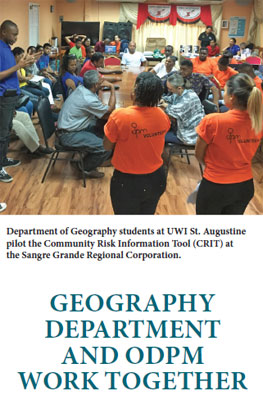
 The active 2017 hurricane season undeniably showed that disasters are becoming more frequent and intense worldwide. To increase the awareness of disasters, the United Nations recognises International Day for Disaster Reduction (IDDR) annually on October 13. This day focuses on promoting a global culture of risk-awareness, disaster preparation, and the reduction of communities’ exposure to disasters. The active 2017 hurricane season undeniably showed that disasters are becoming more frequent and intense worldwide. To increase the awareness of disasters, the United Nations recognises International Day for Disaster Reduction (IDDR) annually on October 13. This day focuses on promoting a global culture of risk-awareness, disaster preparation, and the reduction of communities’ exposure to disasters.
To commemorate the IDDR, the Office of Disaster Preparedness Management (ODPM) partnered with Geography students of The UWI St. Augustine to pilot the use of a hazard and vulnerability data collection tool. The tool is referred to as the Community Risk Information Tool (CRIT) and was engineered by the Caribbean Disaster Emergency Management Agency (CDEMA) and other key stakeholders.
CRIT is intended for use in the selection of communities for disaster risk reduction actions by any stakeholder (e.g. Government, NGOs). It helps to improve coordination and reduces the duplication of effort through the identification of multiple stakeholders working in similar areas or sectors.
For the duration of the data collection phases of the CRIT, while collaborating with the ODPM, the students had hands-on practical application of the theory learned in class. The day after IDDR, data was collected in three regional corporations in Trinidad: Diego Martin, Sangre Grande and Tunapuna/Piarco. Qualitative disaster susceptibility, vulnerability and capacity data was collected. For example, through the information provided by local residents, the tool determines the most frequent hazards, the scale, and severity of hazards. It also highlights the most vulnerable in the respective study area.
Another element is the collection of hazard and vulnerability data from indigenous people. As the intensity and frequency of disasters increase due to climate change, there is a growing need for indigenous knowledge. A plethora of equations and algorithms presently exists to calculate disaster risk and vulnerability. A more effective approach to reduce hazard susceptibility is to broaden the disaster assessment process to include in indigenous knowledge. The acknowledgement of the significance of indigenous knowledge in deriving mitigation, preparedness risk reduction initiatives is growing internationally.
It was fitting that IDDR 2017 and First People’s Day were commemorated on the same day.
|





